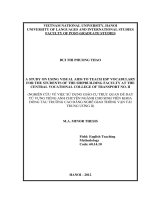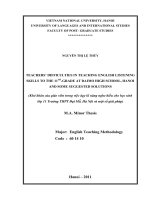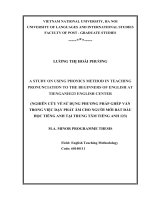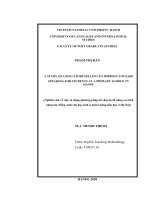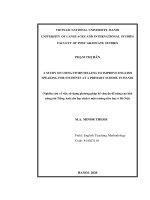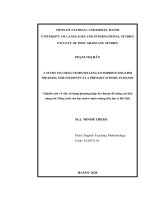A study on using visual aids in english classroom for 11th grade at a high school in gia lai province
Bạn đang xem bản rút gọn của tài liệu. Xem và tải ngay bản đầy đủ của tài liệu tại đây (870.19 KB, 96 trang )
MINISTRY OF EDUCATION AND TRAINING
QUY NHON UNIVERSITY
NGUYEN THI LAN
A STUDY ON USING VISUAL AIDS IN ENGLISH
CLASSROOM FOR 11TH GRADE AT A HIGH SCHOOL IN
GIA LAI PROVINCE
Field: Theory and Methodology of English Language
TeachingCode:8140111
Supervisor: Bui Thi Dao, PhD
BỘ GIÁO DỤC VÀ ĐÀO TẠO
TRƯỜNG ĐẠI HỌC QUY NHƠN
NGUYỄN THỊ LAN
NGHIÊN CỨU SỬ DỤNG PHƯƠNG TIỆN TRỰC QUAN TRONG
TIẾT HỌC TIẾNG
ANH CHO LỚP 11 TRƯỜNG TRUNG HỌC PHỔ THÔNG Ở
TỈNH GIA LAI
Ngành:Lý luận và phương pháp dạy học bộ môn Tiếng Anh
Mã số: 8140111
Người hướng dẫn:TS. Bùi Thị Đào
i
STATEMENT OF AUTHORSHIP
I now declare that this thesis has not previously been submitted for a
degree or diploma in any university. I have not used any sources other than
those listed and identified as references. I further declare that I have not
submitted this thesis at any other institution to obtain a degree.
Signed:
Date: 31/10/2023
Nguyễn Thị Lan
i
ACKNOWLEDGEMENTS
First of all, I would like to acknowledge the debt of gratitude to my
supervisor, Bui Thi Dao, Ph.D. for her helpful suggestions, invaluable critical
feedback, and encouragement in the writing of this study. Without her guidance
and help, this work would not have been completed.
I want to thank those who participated in my research for their valuable time
fulfilling the questionnaire and the insightful information from the
questionnaire. If it had not been for their willingness and enthusiasm, I could
not have collected important data from the study.
My deepest gratitude also extends to all of my wonderful classmates for
the time we shared as well as the information and experience we gained from
one another. Their continuous support and encouragement mean a lot to me in
the accomplishment of this study.
Finally, I would also like to express my thanks to my family and my
husband for their wholehearted encouragement and support during the time I
focused on my thesis.
ii
ABSTRACT
This study investigates issues relating to using visual aids in English classrooms
for grade 11 at a high school in Gia Lai province. It aims to explore the EFL
teachers’use of visual aids in English classrooms and to find out whether using
visual aids in English classrooms has positive impacts on students’ motivation
and active participation during English lessons. The data were collected
through questionnaires, interviews, and classroom observations. Eight teachers
and ninety-two students at a high school in Chu Pah district, Gia Lai province
participated in the study. The results of the study showed that teachers
frequently used different kinds of visual aids in their lessons. Besides, both
teachers and students had positive opinions toward the application of visual
aids in language classrooms. As a result, some recommendations were made
based on the major findings to minimize problems and maximize the
implementation of visual aids in English classrooms at high schools.
iii
TABLE OF CONTENTS
STATEMENT OF AUTHORSHIP ................................................................... i
ACKNOWLEDGEMENTS ............................................................................... i
ABSTRACT ...................................................................................................... ii
TABLE OF CONTENTS ................................................................................. iii
LIST OF ABBREVIATIONS ........................................................................... v
LIST OF TABLES ........................................................................................... vi
LIST OF FIGURES......................................................................................... vii
CHAPTER 1. INTRODUCTION ..................................................................... 1
1.1. Rationale..................................................................................................... 1
1.2. Aims of the study .................................................................................... 3
1.3. Objectives of the study............................................................................ 4
1.4. Research questions .................................................................................. 4
1.5. Scope of the study ................................................................................... 4
1.6. Significance of the study......................................................................... 4
1.7. Structure of the thesis ................................................................................ 5
CHAPTER 2. LITERATURE REVIEW ......................................................... 7
2.1. An overview of visual aids ..................................................................... 7
2.1.1. Definition of visual aids.................................................................... 7
2.1.2. Types of visual aids .......................................................................... 8
2.1.3. Visual aids in language acquisition .................................................. 9
2.1.4. Roles of visual aids in the classroom.............................................. 10
2.1.5. Using visual aids in the classroom.................................................. 11
2.1.6. Use of visual aids in approaches of ELT ........................................ 13
2.2. Students’ motivation and participation ................................................. 14
2.2.1. Students’ motivation ....................................................................... 14
2.2.2. Kinds of motivation for learning English ....................................... 14
2.2.3. Students’ participation .................................................................... 16
2.3. Review of previous studies ................................................................... 17
2.4. Summary ............................................................................................... 21
iv
CHAPTER 3. METHODOLOGY .................................................................. 22
3.1. Research Approach ............................................................................... 22
3.1.1. Participants ................................................................................... 23
3.2. Data collection instruments................................................................... 25
3.2.1. Questionnaires ................................................................................ 25
3.2.2. Observation ..................................................................................... 28
3.2.3. Interview ......................................................................................... 30
3.3. Data collection procedure ..................................................................... 31
3.4. Data analysis methods........................................................................... 31
3.5. Summary ............................................................................................... 32
CHAPTER 4. FINDINGS AND DISCUSSION ............................................ 33
4.1. Research question 1: To what extent do teachers use visual aids in
teaching English? ......................................................................................... 33
4.1.1. Finding from teachers’ questionnaire ............................................. 33
4.1.2. Findings from the interview............................................................ 42
4.1.3. Findings from the observations ...................................................... 46
4.2. Research question 2: How does the use of visual aids influence
students’ motivation and participation in the English classroom? .............. 52
4.2.1. Findings from the students’ questionnaires .................................... 52
4.3. Discussion ............................................................................................. 60
4.3.1 EFL teachers’ using visual aids in English classrooms. .................. 60
4.3.2. The influences of using visual aids on students’ motivation and
participation in English classrooms. ......................................................... 62
5.1. Conclusion ............................................................................................ 65
5.2. Limitations ............................................................................................ 66
5.3.1. Suggestions for School Administrators: ......................................... 67
5.3.2. Recommendations for Teachers: .................................................... 68
APPENDIXES ................................................................................................ 75
v
LIST OF ABBREVIATIONS
EFL: English as a Foreign Language
L2: Second Language
ELT English Language Teaching
vi
LIST OF TABLES
Table 3.1: Background information of the teachers (N=8)............................. 23
Table 3.2: Background information of the students (N=92)........................... 24
Table 3.3. Description of items in the questionnaire for teachers .................. 27
Table 3.4. Description of items in the questionnaire for students .................. 28
Table 4.1. Type of visual aids that teachers use in their teaching .................. 35
Table 4.2. The circumstances when teachers made use of visual aids ........... 36
Table 4.3. The sources of visual aids used by teachers .................................. 38
Table 4.4. Teachers’ consideration of the effectiveness of visual aids in the
classrooms..................................................................................... 39
Table 4.5. Teachers’ consideration of the challenge of visual aids in the
classrooms..................................................................................... 41
Table 4.6. Kinds of visual aids teachers used ................................................. 47
Table 4.7. Types of visual aids used in language skills .................................. 49
Table 4.8 Level of students’ interaction with visual aids ... Error! Bookmark
not defined.
Table 4.9. Students’ opinions on the frequency of each visual aid used (N=92)...53
Table 4.10. Students Engagement in lessons incorporated with visual aids
(N=92)........................................................................................... 53
Table 4.11. Students’ Motivation in lessons incorporated with visual aids
(N= 92).......................................................................................... 54
Table 4.12. The kinds of visual aids students like to study with (N=92)................55
Table 4. 13. Students ’ opinions on the benefits of visual aids (N=92) ..................56
Table 4.14. Students’ satisfaction with the use of visual aids in their English
classroom(N= 92) ....................................................................................59
vii
LIST OF FIGURES
Figure 4. 1. Teachers’ use of visual aids in the classroom ............................. 33
Figure 4. 2. Frequency of the use of visual aids in English teaching ............ 34
Figure 4.3. Teachers’ consideration of the importance of visual aids in the
classrooms..................................................................................... 35
Figure 4.4. Teachers’ challenge of using visual aids in the classrooms ....... 40
Figure 4.4. Teachers’ intention of using visual aids in the future ................. 42
Figure 4.5. Frequency of visual aids used by teachers ................................... 48
Figure 4.6. Students' opinions on the frequency of visual aids used by ........ 51
1
CHAPTER 1
INTRODUCTION
This chapter presents such topics as the background of the study,
statements of the problem, the purpose of the study, significance of the study,
scope, and structure of the study.
1.1. Rationale
Technological advancements crafted by humans have caused the world
to become smaller. Traveling and communicating with other societies around
the world are considerably simpler today. We exchange cultures, ideas, and
values, making the world more interconnected. English, the most widely
spoken language in the world, must be understood and used to communicate on
such a large scale (Fidanboylu, 2014). As a result, there is a growing necessity
for millions of individuals worldwide to acquire English as a second language,
as highlighted by Crystal (2005) as cited in Gonzales, Houghton, Kaye & and
Stewart (2012). Acquiring proficiency in a language that significantly differs
from one's native tongue presents a formidable challenge, particularly in today's
technology-driven age where traditional teaching methods alone appear
inadequate. Prior studies have demonstrated that incorporating audio-visual
materials, including images, diagrams, presentations, videos, and audio
resources, into the language learning process can make a substantial and
valuable contribution to supplement traditional resources like textbooks, oral
instruction, and exercises, as evidenced by Narayan (1980).
Undoubtedly, the integration of technology into the teaching and
learning dynamic is an undeniable reality. In other words, educators should
carefully choose suitable technological tools that align with their specific
teaching and learning contexts to enhance their students' educational
experiences, as suggested by Ismail (2006). For instance, when instructing
students in English speaking skills, the incorporation of audiovisual materials
2
enhances the teaching and learning process, making it more hands-on and
interactive. These multimedia resources not only render language lessons more
engaging but also infuse vitality into the classroom by captivating students'
attention, whether directed at the teacher or the subject matter.
Capper (2003) highlights that technological tools should function as
complementary supports to the curriculum rather than overpower it and that
numerous teachers, despite having access to technology, refrain from its use
due to their lack of technical expertise and contentment with their current
teaching methods. He suggests that these instructors encounter challenges when
utilizing technology or struggle to find the time to incorporate tech-supported
lessons effectively. A proficient amalgamation of teaching resources and
strategies enhances the learning environment.
English Language Teaching (ELT) is considered one of the popular
communication language teaching approaches nowadays, according to
Freeman (2000), and different innovations are brought in the field of ELT to
come out from the traditional teaching approaches. ELT was introduced in the
early 1980s to practice language expressed in daily communication around the
classroom. Learners can learn another language after their mother tongue to
maintain communication with others in a different language. As a result, with
the changed necessity of learning the English language, teaching methods and
approaches have also been adapted. That is the reason why teachers of English
are trying to bring innovations and approaches in their teaching to make their
lessons more effective. In this approach, the use of visual aids has been highly
emphasized. As Patesan et al. (2018) stated, visual aids are considered powerful
tools used for the ELT process, especially in high schools where students are
under the pressure of studying a variety number of subjects and often ignore
the importance of studying English in modern life.
Moreover, from my own experience as a teacher of English in high
3
school for several years, I am aware of the fact that teaching English is not an
easy task, especially in high school, hence, it needs to be interesting enough to
remove the anxiety of the learners. For this reason, teachers tend to deal with
different techniques to teach English more interestingly. With the rapid growth
and availability of technology, teaching English is incorporating different
additional aids along with the textbooks to teach. Apart from electronic boards,
overhead transparency, multimedia projectors, computers, visual aids such as
wallboard, roll-up board, pictures, posters, charts, cartoons, cue sheets, flannel
boards, and flashcards are also important approaches to make the teaching and
learning processes become interesting and enjoyable. Teachers, thus, seek ways
to deal with visual aids in their lessons to attract students with better learning
conditions and increase the student’s interest, knowledge, and proficiency in
English learning.
For all the above reasons, using visual aids in English classrooms has
become a challenging task for every teacher of English at high schools. It is
worth noting that the instruction of applying visual aids has been provided in a
limited way since different teachers have their own way of using visual aids.
This fact is one of the motivations that inspired me in my decision to work on
the theme. From the outcome, an insightful investigation into “A study on
using visual aids in English classrooms for 11th grade at a high school in Gia
Lai province” is carried out to examine the perceptions of English teachers in
a high school in Gia Lai province toward the use of visuals aids in English
classrooms and to attract learners’ interest in English classroom so that they
can study better and avoid boringness, and then to some extents, to give some
practice value on English teaching using visual aids in the classroom.
1.2. Aims of the study
This study aimed to explore the EFL teachers’use of visual aids in English
classrooms and to find out whether using visual aids in English classrooms has
4
positive impacts on students’ motivation and active participation during
English lessons.
1.3. Objectives of the study
The study proposes the objectives as follows:
a. To identify EFL teachers’ using visual aids in English classrooms.
b. To explore the influences of using visual aids on students’ motivation
and participation in English classrooms.
1.4. Research questions
The study aims to answer the following research questions:
1. To what extent do teachers use visual aids in teaching English?
2. How does the use of visual aids influence students’ motivation and
participation in the English classroom?
1.5. Scope of the study
This study aims to describe the teachers’s use of visual aids in English
classrooms and explore the influences of using visual aids on students’
motivation and participation based on the theory framework of Ashokia (2009).
Thus, the questionnaire, interview, and observation were used to collect data from
eight high school teachers and ninety-two grade 11 students from a high school in
Chu Pah district, Gia Lai province.
1.6. Significance of the study
The findings of this study are anticipated to make a valuable contribution to
teachers in a high school in Gia Lai province who employ visual aids. It also
offered insights into how both teachers and students perceived the usage of
these aids. Despite its limitations, this study holds significance both in
theoretical and practical terms.
Theoretically, this study offered valuable information to school
administrators regarding the challenges their teachers encountered. It also
5
recommended the type of support that should be extended to encourage teachers
to utilize visual aids more frequently and effectively, ultimately enhancing the
quality of instruction.
In terms of practical implications, this study is expected to offer several
benefits. Firstly, it has the potential to enhance language teachers'
understanding of the application of visual aids in English classrooms. The
study's outcomes can be a valuable resource for high school English teachers,
providing insights into the effective utilization of visual aids in the teaching and
learning process, thereby enhancing the quality of education to achieve desired
learning outcomes. Secondly, this research is poised to contribute to increasing
students' interest and motivation in learning English, particularly through the
utilization of visual aids. It is envisaged that the study's results will help make
English lessons more engaging and appealing to students.
Lastly, this research is intended to serve as a reference point for future
researchers interested in conducting similar studies. It is poised to make a
meaningful contribution to the teaching and learning processes, particularly in
the use of visual aids in English lessons.
1.7. Structure of the thesis
The thesis is presented in five chapters: Introduction, Literature Review,
Methodology, Findings and Discussion, Conclusion and Implications.
Chapter 1, Introduction, presents the rationale, which introduces the reasons
why the researcher chose to conduct the study, the aim and objectives, the
research questions, the scope, the significance, the definition of important
terms, and the structure of the thesis.
Chapter 2, Literature Review and Theoretical Background: shows some
previous relevant studies and relevant theoretical background for the study.
Chapter 3, Methodology, explains the research methods. Firstly, it presents the
6
research approach. Secondly, it describes the participants. Thirdly, it introduces
the research instruments used to collect data. Lastly, this chapter comes to an
end with the procedure to conduct the study.
Chapter 4, Findings and Discussion, reports the results of the study. First of all,
the reliability of the instruments is introduced. Then, the information collected from
the questionnaire is analyzed. Finally, the data from the observations is analyzed to
give an in-depth explanation of the findings of the study.
Chapter 5, Conclusion and Implications, concludes the report of the study. First,
it summarizes the main findings of the study. Then, it suggests the research
implications. Finally, the limitations of the study and the suggestions for future
research make up the last part of this chapter.
7
CHAPTER 2
LITERATURE REVIEW
In this chapter, a literature review related to visual aids will be described.
In particular, an overview of visual aids including definition and types of visual
aids, visual aids in language acquisition, roles of visual aids in the classroom,
using visual aids in the classroom, use of visual aids in approaches of ELT, and
students’ motivation and participation together with previous studies have been
mentioned.
2.1. An overview of visual aids
2.1.1. Definition of visual aids
Using visual aids in teaching different language skills in English
classrooms is becoming popular nowadays among the teachers of English at
high schools. There have been given different definitions by different scholars
during the past few decades. Weaver & Bollinger (1949) outlined the term
"visual aids" as any type of prepared "drawing, illustration, model, motion
picture, film strip" or other tool that will support learning through vision
cognition. Cakir & Ismail (2006) introduced one concept that is accepted
immensely at present which defines visual aids as any kind of “drawing,
illustration, model, motion picture, a film strip that is prepared or any device
that will assist the learning process through the vision cognition.”
According to Ashokhia (2009), visual aids are “the materials that can be
seen like pictures, posters, graphics, videos, charts, flashcards, etc.”
Babalola (2018) considers visual aids as any type of media or aids
carrying information used to encourage the effective teaching and learning
process, therefore it can be understood as a means to support the teaching
process to help students achieve higher performance.
Patesan (2018) defines visual aids as “an additional tool in the teaching-
8
learning process when appropriately chosen and designed are important as
students are stimulated, motivated and focused on the activities in class to
enhance learning.”
It is generally said that each scholar at their time had their definition and
ideas of visual aids. In this study, the concept introduced by Babalola ( 2013)
was applied, encompassing a wide range of educational tools and resources
used to enhance the teaching process for educators and improve academic
outcomes for students of grade 11 in Mac Dinh Chi High School.
2.1.2. Types of visual aids
When it comes to the varieties of visual aids available for teaching, Eline
(1984) points out that there exist numerous options that educators can employ
to enhance the learning environment's appeal to students. These options
encompass materials like handouts, realia, flipcharts, PowerPoint
presentations, chalkboards, posters, objects or models, overhead projectors,
computers, images, gestures, and more.
The utilization of visual aids plays an essential role in the instruction of
language. As Yunus (2006) stated, employing visual aids in language teaching
serves to stimulate and inspire students during the learning process, making it
more accessible for them to grasp new ideas and information. Lin (2007) and
Mayer (2003) both define visual aids as "advanced organizers" or tools that
emphasize different skills. Furthermore, Mohammadi, Moenikia & Zahed-
Babelan (2010) assert that the use of advanced organizers, which are essentially
visual aids, yields positive outcomes compared to traditional teaching methods.
Asokhia (2009) categorized visual aids as items that can be observed or
watched, dividing them into several types: Asokhia (2009) categorized
visual aids, which encompass any items that can be visually perceived, into
various categories:
1. Posters, characterized by their large size and vibrant colors, are engaging for
9
students and can be utilized for various classroom activities and games.
2. Cartoons, television, and videos are employed to reinforce the topics
being studied.
3. The Internet offers an extensive array of resources suitable for all
grade levels.
4. Chalkboards, when divided into sections for distinct teaching areas, can
be enhanced with colored chalk to emphasize different educational elements.
5. Flashcards consist of images on one side and text on the other, making
them versatile for presenting question-answer pairs, visual representations of
objects, subject-related images, and more.
In this study, Asokhia's (2009) classification of visual aids was considered,
as it aligns with the teaching practices familiar to educators in the study's
context. Additionally, the study recognized other methods of visual
representation, such as pictures, objects, and gestures, as visual aids, as these
methods also serve the purpose of "conveying information to facilitate effective
teaching and learning," as defined by Babalola (2013).
To sum up, the types of visual aids investigated in this study include posters,
videos, Internet, chalkboard and colored chalk, and flashcards as classified by
(Asokhia 2009), together with three other popular means for visual illustration
which are pictures, objects, and gestures.
2.1.3. Visual aids in language acquisition
The cognitive approach pertains to the process of language acquisition
with the aid of visual tools. Some scholars have introduced theories that address
the importance of the cognitive approach, particularly about input. These
theories include the dual-coding theory and the image schema theory, both of
which are closely linked to the interplay between visual cognition, human
perception, and the world.
The input that learners receive during their learning journey plays a
10
central role in the process of language acquisition, as highlighted by Bahrani
(2013). Consequently, various methods have been introduced to facilitate
access to the desired language input. Fotos (2001) held the belief that the input
students encounter in the classroom can be adapted to suit the proficiency level
and age range of the students. According to Halwani (2017), visual aids are
indispensable for second language acquisition because they can function as a
means to illustrate the relationship between words and their meanings. Therefore,
they prove valuable for the accumulation of language input.
Paivio (1991) posits that cognition can be divided into two subsystems:
a verbal one and a non-verbal one. The verbal subsystem is primarily engaged
in processing language directly, while the non-verbal subsystem is dedicated to
handling non-linguistic objects and events. The synergy between these two
systems is of paramount importance in the study of language. Consequently,
"the combination of visual aids, mental imagery, and verbal explanations can
serve as an effective technique to enhance comprehension and facilitate
learning from text, applicable across a wide spectrum of learners, from primary
school to university levels" (Paivio, 1991, p. 163).
In summary, direct, real-world engagement plays a pivotal role in the
knowledge acquisition process. Thus, establishing a meaningful classroom
environment that mirrors real-life situations is beneficial and essential for
language learners.
2.1.4. Roles of visual aids in the classroom
Mitchell and Myles (2004) asserted that making second language
acquisition more manageable involves focusing on the cognitive processes of
the brain and the acquisition of new information. Geeraerts (2006) proposed
the theory that language doesn't independently construct concepts within an
individual's mind; rather, it mirrors people's real-life experiences. Language
originates from real-world encounters. Consequently, to attain the highest

